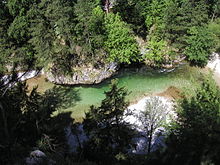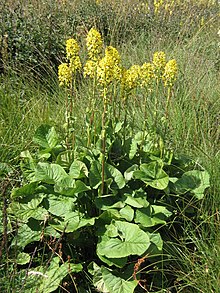European Protected Areas of the Northeastern Rim Alps
Coordinates: 47 ° 53 ′ 0 ″ N , 15 ° 59 ′ 0 ″ E
Under the official name of the European Protected Areas Northeast Rim Alps: Hohe Wand - Schneeberg - Rax and Northeast Rim Alps , the state of Lower Austria includes the Natura 2000 areas bird sanctuary Northeast Rim Alps (AT1212A00) and FFH area Northeast Rim Alps: Hohe Wand-Schneeberg-Rax (AT1212000) a joint management plan. The FFH area is the largest protected area in Lower Austria with 64,090 ha, three quarters of the bird sanctuary is within the FFH area and is also significantly smaller with a total of 5,440 ha. Together, the two European protected areas cover an area of 65,240 ha. The protected areas are located in the main industrial area .
location
The protected areas are located on the eastern edge of the northern limestone Alps in front of the flat landscapes of the Pannonian basin . The two areas affect the following municipalities:
basis
The legal basis for the area are the Habitats Directive of the European Union and ordinances of the Lower Austrian provincial government. A joint management plan was drawn up for the areas.
Flora, fauna and habitats
Habitats
Due to its great elevation, the protected area accommodates between 280 m and 2070 m above sea level. A. and the location in a transition zone from the Atlantic influenced alpine to the continental Pannonian climate, numerous different habitats for plants and animals.
| Habitat type | Natura 2000 code | Assessment (representativeness, relative area and state of preservation) |
|---|---|---|
| Mud flats | 3130 | significant |
| Candle algae societies | 3140 | significant |
| Alpine rivers with lavender willow-sea buckthorn bushes | 3240 | outstanding |
| Buttercup Societies | 3260 | significant |
| Carbonate pine bushes * | 4070 | outstanding |
| Gappy pioneer lime lawn * | 6110 | outstanding |
| Alpine limestone grasslands | 6170 | Well |
| Trespen-fescue-limestone dry lawn | 6210 | Well |
| Bristle grass lawn * | 6230 | Well |
| Eastern European steppes * | 6240 | Well |
| Pipe grass meadows | 6410 | significant |
| Moist tall herbaceous vegetation | 6430 | Well |
| Smooth oat meadows | 6510 | Well |
| Gold oat meadows | 6520 | Well |
| Tufa springs * | 7220 | Well |
| Lime-rich fens | 7230 | Well |
| Lime and slate heaps | 8120 | Well |
| Thermophilic rubble heaps in the Alps | 8130 | Well |
| Natural limestone rock with crevice vegetation | 8210 | Well |
| Caves that are not open to tourists | 8310 | significant |
| Grove beech forests | 9110 | Well |
| Mull brown earth beech forests | 9130 | Well |
| Subalpine beech forest with maple | 9140 | Well |
| Dry-slope limestone beech forests | 9150 | Well |
| Bedstraw-oak-hornbeam forests | 9170 | Well |
| Mixed ravine and hillside forests * | 9180 | Well |
| Alder-ash-willow meadows * | 91E0 | Well |
| Bog forests * | 91D0 | Well |
| Pannonian oak-hornbeam forests * | 91G0 | significant |
| Pannonian downy oak forests * | 91H0 | outstanding |
| Acid spruce forests | 9410 | Well |
| Alpine forests with larch and stone pine | 9420 | significant |
| Sub-Mediterranean pine forests with endemic black pines * | 9530 | Well |
animals and plants
The preservation of the bat species, which, in addition to large occurrences in the forests and settlement areas of the area in the Hermannshöhle, have an internationally important quarter, represents a development goal of the area.
The area is the habitat of the following species that are listed in Appendix II of the Habitats Directive; priority species are marked with *. The assessment is taken from the standard data sheet.
| Natura 2000 code | Art | Assessment (population, conservation and isolation) |
|---|---|---|
| VERTEBRATES | ||
| Mammals | ||
| 1335 | European ground squirrel | Well |
| 1354 * | brown bear | significant |
| 1355 | Otter | Well |
| Bats | ||
| 1303 | Little horseshoe bat | outstanding |
| 1304 | Great horseshoe bat | Well |
| 1307 | Little mouse ear | significant |
| 1308 | Pug bat | Well |
| 1321 | Ciliate bat | significant |
| 1323 | Bechstein's bat | significant |
| 1324 | Great mouse ear | Well |
| Amphibians | ||
| 1167 | Alpine crested newt | Well |
| 1193 | Yellow-bellied toad | Well |
| Fish and lampreys | ||
| 1149 | Wolffish | significant |
| 1163 | Koppe | Well |
| INVERTEBRATE | ||
| Beetle | ||
| 1084 * | hermit | Well |
| 1085 | Gold-streaked jewel beetle | significant |
| 1087 * | Alpine buck | Well |
| Butterflies | ||
| 1060 | Big fire butterfly | significant |
| 1074 | Hedge wool jack | significant |
| 1078 * | Russian bear | Well |
| Snails | ||
| 1014 | Narrow diaper snail | significant |
| 1915 * | Austrian heather snail | Well |
| PLANTS | ||
| 1758 | Siberian gold flask | outstanding |
| 1902 | Yellow lady's slipper | outstanding |
Species in the bird sanctuary
Significant bird species of Annex I of the Birds Directive in the bird sanctuary are:
| Natura 2000 code | Art | evaluation |
|---|---|---|
| A072 | Honey buzzard | significant |
| A122 | Corn Crake | significant |
| A215 | Eagle owl | significant |
| A224 | Goat milker | significant |
| A234 | Gray woodpecker | significant |
| A236 | Black woodpecker | significant |
| A246 | Woodlark | significant |
| A338 | Red backs | significant |
| A429 | Blood woodpecker | significant |
Conservation goals
The management plan defines important conservation objectives for the protected areas. The aim is to maintain or restore a sufficient extent of the habitats characteristic of the protected area. This includes forest stands with a near-natural or natural age composition, primary locations of the forest type Mediterranean pine forests and near-natural transitions from forest to open land areas along the thermal line. Within the agriculturally used areas, the open cultural landscape of vineyards, well-structured cultivated wine-growing areas and extensively used grassland areas are taken into account. Other open land areas to be preserved are wet and valley greasy meadows and poor meadows and pastures (semi-arid grassland). Karst formations characteristic for the area are promoted in the form of the undisturbed natural caves and at least during the breeding season undisturbed rock formations. Other conservation goals apply to natural, unaffected alpine habitats and near-natural waters.
Web links
Individual evidence
- Coordinate (FFH area) according to 2010/42 / : Commission decision of 22 December 2009 on the adoption of a third updated list of areas of Community importance in the Alpine biogeographical region in accordance with Council Directive 92/43 / EEC (announced at Case number K (2009) 10415). Official Journal No. L 030 of 02/02/2010 p. 0001-0042, Annex Third updated list of sites of Community importance in the Alpine biogeographical region
- ^ Ordinance on the notified sites of Community importance , April 16, 2017
- ↑ Ordinance on European Protected Areas , April 16, 2017
- ↑ a b standard data sheet
- ↑ http://www.noe.gv.at/bilder/d37/1_12_Erhaltungsziel.pdf?14854 ( page no longer available , search in web archives ) Info: The link was automatically marked as defective. Please check the link according to the instructions and then remove this notice.


